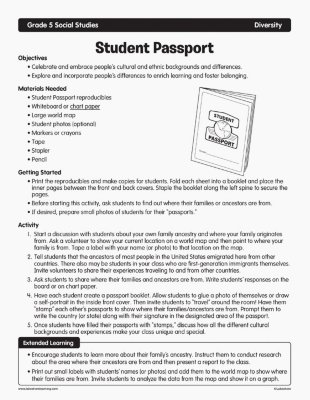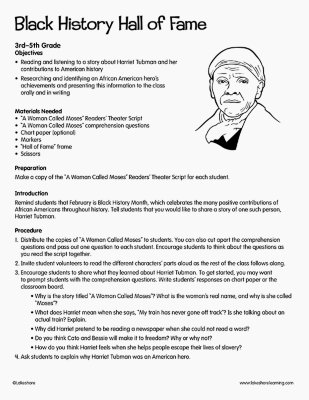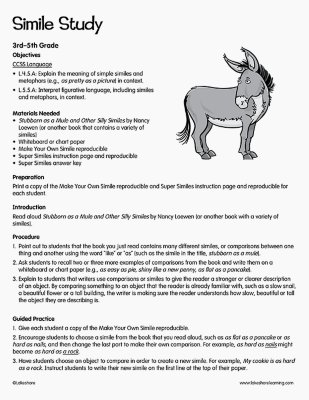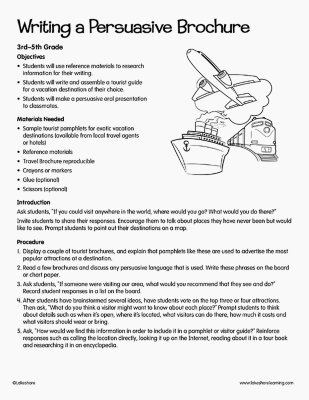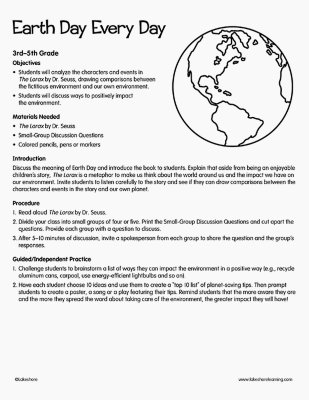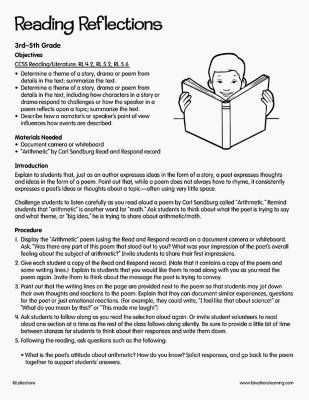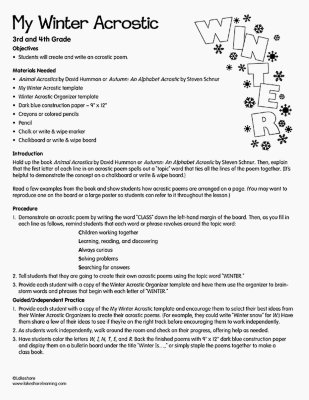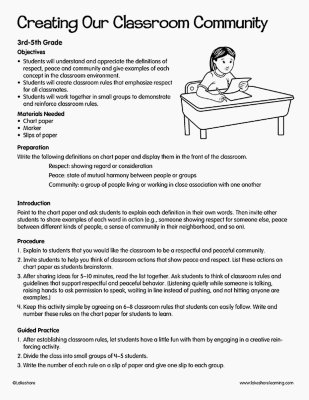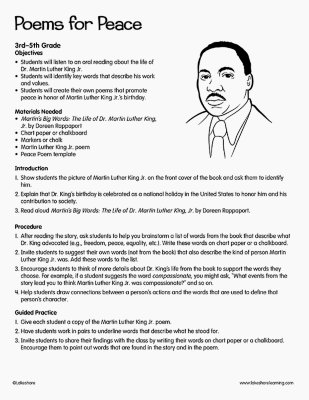Narrow by Grade
- Infant (0)
- Toddler (0)
- Preschool (0)
- Pre-K (0)
- Kindergarten (0)
- 1st (0)
- 2nd (0)
- 3rd (6)
- 4th (6)
- 5th (10)
- 6th & Up (0)
Grade
Narrow by Age
- 0-18m (0)
- 18-36m (0)
- 3 yrs. (0)
- 4 yrs. (28)
- 5 yrs. (38)
- 6 yrs. (38)
- 7 yrs. (30)
- 8 yrs. (33)
- 9 yrs. (32)
- 10 yrs. (10)
- 11 yrs. & Up (0)
Age 10 yrs.
10 results for "student"
Filters
Clear All
Student Passport
5th Grade
Objectives
- Celebrate and embrace people’s cultural and ethnic backgrounds and differences.
- Explore and incorporate people’s differences to enrich learning and foster belonging.
Black History Hall of Fame
3rd Grade - 5th Grade
Objectives Reading and listening to a story about Harriet Tubman and her contributions to American history Researching and identifying an African American hero’s achievements and presenting this information to the class orally and in writing Materials Needed “A Woman Called Moses” Readers’ Theater Script “A Woman Called Moses” comprehension questions Chart paper (optional) Markers “Hall of Fame” frame Scissors Preparation Make a copy of the “A Woman Called Moses” Readers’ Theater Script for each student. Introduction Remind students that February is Black History Month, which celebrates the many positive contributions of African Americans throughout history. Tell students that you would like to share a story of one such person, Harriet Tubman.
View Lesson PlanSimile Study
5th Grade
Objectives CCSS Language L.4.5.A: Explain the meaning of simple similes and metaphors (e.g., as pretty as a picture) in context. L.5.5.A: Interpret figurative language, including similes and metaphors, in context. Materials Needed Stubborn as a Mule and Other Silly Similes by Nancy Loewen (or another book that contains a variety of similes) Whiteboard or chart paper Make Your Own Simile reproducible Super Similes instruction page and reproducible Super Similes answer key Preparation Print a copy of the Make Your Own Simile reproducible and Super Similes instruction page and reproducible for each student. Introduction Read aloud Stubborn as a Mule and Other Silly Similes by Nancy Loewen (or another book with a variety of similes).
View Lesson PlanWriting a Persuasive Brochure
3rd Grade - 5th Grade
Objectives Using reference materials to research for their writing Introducing the topic or text they are writing about, stating an opinion and creating an organizational structure that lists reasons Providing reasons that support the opinion Reporting on a topic or text, telling a story, or recounting an experience in an organized manner, using appropriate facts and relevant, descriptive details to support main ideas or themes; speaking clearly at an understandable pace Materials Needed Sample tourist pamphlets for exotic vacation destinations (available from local travel agents or hotels) Reference materials Travel Brochure reproducible Crayons or markers Glue (optional) Scissors (optional) Introduction Ask students, “If you could visit anywhere in the world, where would you go? What would you do there?” Invite students to share their responses. Encourage them to talk about places they have never been but would like to see. Prompt students to point out their destinations on a map.
View Lesson PlanEarth Day Every Day
3rd Grade - 5th Grade
Objectives Students will analyze the characters and events in The Lorax by Dr. Seuss, drawing comparisons between the fictitious environment and our own environment. Students will discuss ways to positively impact the environment. Materials Needed The Lorax by Dr. Seuss Small-Group Discussion Questions Colored pencils, pens or markers Introduction Discuss the meaning of Earth Day, and introduce the book to students. Explain that aside from being an enjoyable children’s story, The Lorax is a metaphor to make us think about the world around us and the impact we have on our environment. Invite students to listen carefully to the story and see if they can draw comparisons between the characters and events in the story and our own planet.
View Lesson PlanReading Reflections
5th Grade
Objectives CCSS Reading/Literature: RL.4.2, RL.5.2, RL.5.6 Determine a theme of a story, drama or poem from details in the text; summarize the text. Determine a theme of a story, drama or poem from details in the text, including how characters in a story or drama respond to challenges or how the speaker in a poem reflects upon a topic; summarize the text. Describe how a narrator’s or speaker’s point of view influences how events are described. Materials Needed Document camera or whiteboard “Arithmetic” by Carl Sandburg Read and Respond record Introduction Explain to students that, just as an author expresses ideas in the form of a story, a poet expresses thoughts and ideas in the form of a poem. Point out that, while a poem does not always have to rhyme, it consistently expresses a poet’s ideas or thoughts about a topic—often using very little space. Challenge students to listen carefully as you read aloud a poem by Carl Sandburg called “Arithmetic.” Remind students that “arithmetic” is another word for “math.” Ask students to think about what the poet is trying to say and what theme, or “big idea,” he is trying to share about arithmetic/math.
View Lesson PlanMy Winter Acrostic
3rd Grade - 5th Grade
Objectives Reading: Literature Reading and comprehending grade-appropriate literature, including stories, dramas, and poetry Writing Writing an acrostic poem Materials Needed Animal Acrostics by David Hummon or Autumn: An Alphabet Acrostic by Steven Schnur My Winter Acrostic template Winter Acrostic Organizer template Dark-blue construction paper - 9" x 12" Crayons or colored pencils Pencil Chalk or write & wipe marker Chalkboard or write & wipe board Introduction Hold up the book Animal Acrostics by David Hummon or Autumn: An Alphabet Acrostic by Steven Schnur. Then explain that the first letter of each line in an acrostic poem spells out a “topic” word that ties all the lines of the poem together. (It’s helpful to demonstrate the concept on a chalkboard or write & wipe board.) Read a few examples from the book and show students how acrostic poems are arranged on a page. (You may want to reproduce one on the board or a large poster so students can refer to it throughout the lesson.)
View Lesson PlanCreating Our Classroom Community
3rd Grade - 5th Grade
Objectives Understanding and appreciating the definitions of respect, peace and community, and giving examples of each concept in the classroom environment Creating classroom rules that emphasize respect for all classmates Working together in small groups to demonstrate and reinforce classroom rules Describing people, places, things and events with relevant details, expressing ideas and feelings clearly Materials Needed Chart paper Marker Slips of paper Introduction Point to the chart paper and ask students to explain each definition in their own words. Then invite other students to share examples of each word in action (e.g., someone showing respect for someone else, peace between different kinds of people, a sense of community in their neighborhood).
View Lesson PlanPoems for Peace
5th Grade
Objectives Students will listen to an oral reading about the life of Dr. Martin Luther King Jr. Students will identify key words that describe his work and values. Students will create their own poems that promote peace in honor of Martin Luther King Jr.’s birthday. Materials Needed Martin’s Big Words: The Life of Dr. Martin Luther King, Jr. by Doreen Rappaport Chart paper or chalkboard Markers or chalk Martin Luther King Jr. poem Peace Poem template Introduction Show students the picture of Martin Luther King Jr. on the front cover of the book and ask them to identify him. Explain that Dr. King’s birthday is celebrated as a national holiday in the United States to honor him and his contribution to society. Read aloud Martin’s Big Words: The Life of Dr. Martin Luther King, Jr. by Doreen Rappaport.
View Lesson PlanCharacter Building: Bullying
3rd Grade - 5th Grade
Objectives Students will listen and respond to literature read aloud by the teacher. Students will share interpretations of lessons in a story and learn to apply these lessons to their own lives. Materials Needed A Bad Case of Stripes by David Shannon Chalkboard, sentence strips or interactive whiteboard Notebook paper Introduction Ask students if they have a favorite food that might surprise others, like broccoli, spinach or beets! Invite volunteers to tell the class what this surprising food is. Tell students that you are going to read a story in which the main character has an odd choice for a favorite food. Ask students to pay special attention to what happens to this character, how her classmates react to her, and what she does to solve her problem. Read aloud A Bad Case of Stripes by David Shannon.
View Lesson Plan